Reserve Bank of Australia Annual Report – 1996 Financial Markets
Two themes stand out from developments in financial markets over the past year. One is the influence of international linkages in determining domestic outcomes; the other is the demonstration of the benefits that can flow from improvements in inflation expectations.
International linkages
The trend towards increased integration of financial markets is continuing. Events in the world economy, particularly insofar as they impact on commodity prices, have been long recognised as a major influence on the Australian dollar. In recent years, however, the traditional role which the exchange rate has played in transmitting international influences to Australia has been supplemented by the growing responsiveness of bond and equity markets to international influences, in particular those associated with the US economy.
The influence of the US bond market: The course of US interest rates and bond yields remained an important factor influencing bond markets in most countries in 1995/96. In the first half of the year, there was a clear downward trend in US interest rates; this was attributable mainly to a slowing in the pace of expansion in the US economy in response to the earlier tightening of monetary policy. At the same time, pressures on prices proved to be less of a problem than market participants had earlier feared. In this environment, the Federal Reserve eased monetary policy during the second half of 1995 and in early 1996, reversing some of the tightening in the preceding year.
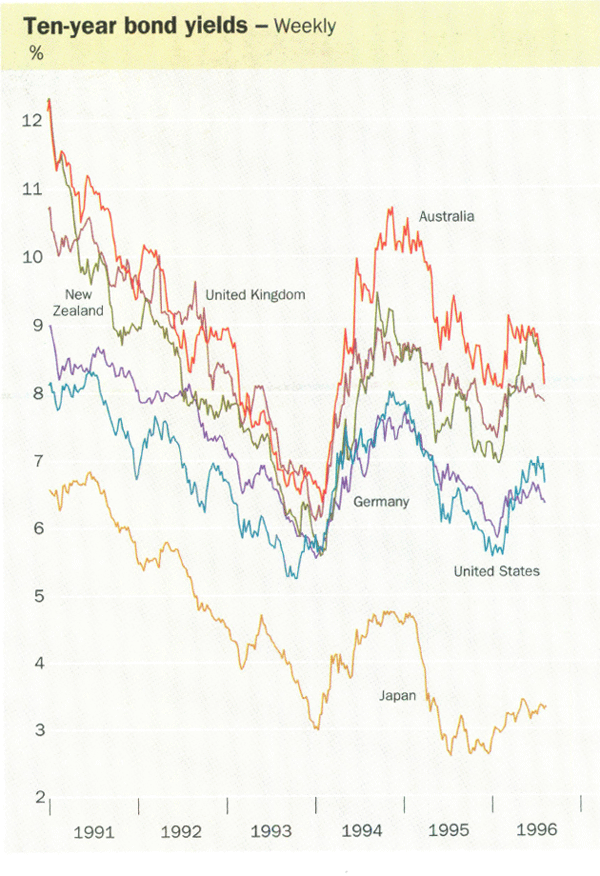
Apart from the course of the US business cycle, two other factors were at work in pushing down bond yields. One was the improving outlook for the US dollar in the second half of 1995. In mid 1995, markets had come to view the historically low level to which the US dollar had fallen, especially against the yen, as a substantial overshooting. The fact that official interest rates in Japan, by that time, had been reduced to less than 0.5 per cent also created a substantial interest differential in favour of the US. This combination of interest rates and exchange rates made US investments very attractive relative to those in Japan. Investors with a global perspective, including so-called “hedge funds”, responded by purchasing US assets, funding their dollar positions by selling Japanese assets and, in some cases, even borrowing in yen.
A further element in the fall in bond yields was the apparent progress towards a durable reduction in the US budget deficit, with the prospect that the budget would be balanced by 2002. This influence was overshadowed, at times, by the political stand-off on the passage of the 1996 budget, but overall developments in US fiscal policy were positive for bond markets around the world.
By the end of 1995, bond yields in the US had reached levels which, while above those reached in late 1993, were still low compared with most of the past decade. The trend turned rather abruptly, however, in early 1996 when Federal Reserve Chairman Greenspan's testimony to Congress in mid February scotched expectations of further monetary policy easing, and when employment and other data on the US economy began to look distinctly firmer.
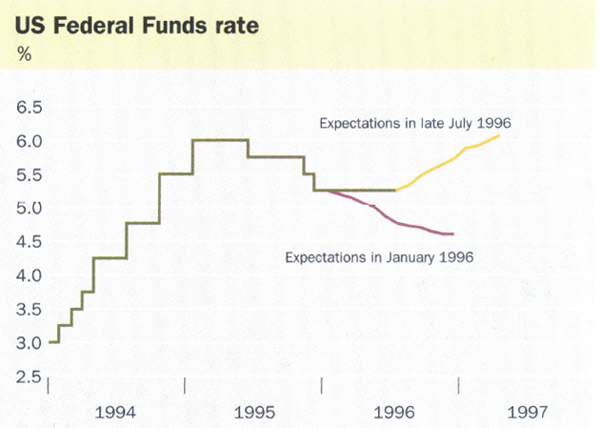
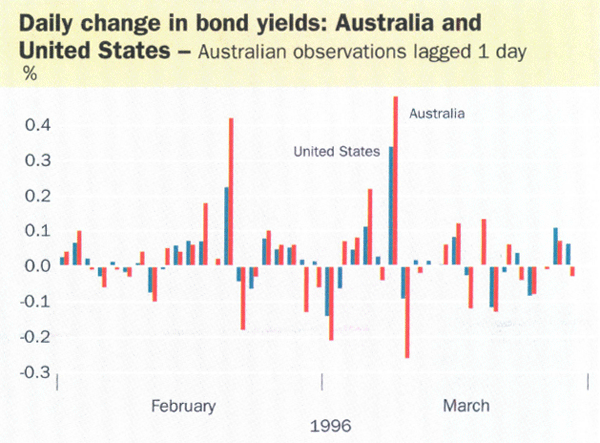
Expectations about US monetary policy, as embodied in financial market prices, turned quickly from easing to tightening, as concerns mounted that the strong growth could generate inflationary pressures. This shift deflated the bullish sentiment in the bond market and yields rose in a series of sharp upward moves, usually associated with the release of employment data early in each month. Amplifying the change, the US dollar/yen exchange rate had become less of a “one-way bet” after its 20 per cent recovery in the second half of 1995, causing some large investors to unwind their earlier positions and sell US securities in the process.
While the factors driving US bond markets were specific to the US economy, bond yields in other countries closely followed US movements. In Australia, the decline in yields begun in early 1995 continued until February 1996, more or less in line with that in US yields, deviating only temporarily in October when wage and price data showed bigger increases than had been expected. Yields on 10-year bonds in Australia fell from about 9 per cent at the start of the financial year to about 8 per cent by January. The turnaround in the US market in early 1996 saw Australian yields rise substantially over February and March, with a high correlation of daily moves between the two countries. Thereafter, Australian yields “decoupled” to some degree from those in the US: whereas US yields continued to move higher, Australian yields remained relatively flat over the remainder of the financial year, and declined noticeably in July to about 8.1 per cent immediately after the easing in monetary policy.
The correlation in movements between the Australian and US markets is understandable to a degree, given the close correspondence of economic cycles in the two countries. Even in countries not synchronised with the US business cycle, however, bond yields have shown strong relationships with US yields in recent years. In Germany, for example, where growth has been weak and inflation has been falling over the past year, bond yields rose early in 1996.
The strengthening in ties between national bond and other capital markets is part of the ongoing “globalisation” process. In the case of capital markets, the trend has proceeded further than in most other areas because of the financial deregulation which has occurred in most countries over the past decade or more, and the advances in information technology which are providing instant international access to market-sensitive news. Investors are coming to view national bond markets as components of one global market; the compilation by investment houses of international bond market indices, based on weighted combinations of national markets, has reinforced this perception. In this world, bonds are increasingly priced as a spread relative to “benchmark” bonds, which in the international context are usually US government securities. In the absence of news specific to a national market, the presumption is that domestic bonds will move broadly in line with the benchmark in the short term.
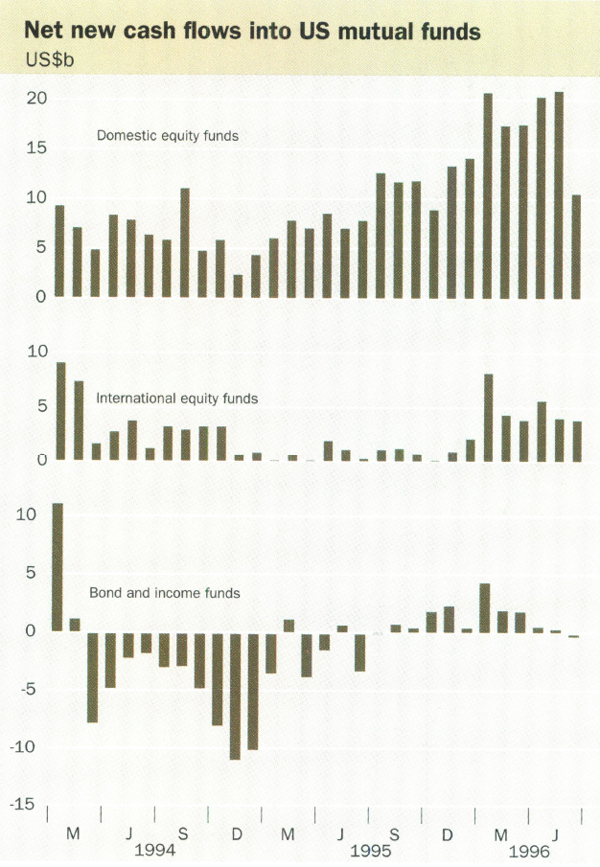
Equity markets: Strong international linkages are also evident in equity markets. While most markets could not match the strong performance of the US market during 1995/96, they followed its direction. By May 1996, US share prices had risen by about 25 per cent since the start of the financial year, and about 50 per cent since the bull market commenced in early 1995. This strength reflected several factors. First, the decline in bond yields during 1995 increased the attractiveness of shares. Secondly, the profitability of US companies generally has been very high on the back of a number of years of solid economic growth and the leading position of US firms in technological development. Expectations about future profitability, moreover, were exceptionally buoyant. A third factor was the unprecedented sums flowing into equity mutual funds from retail investors; in 1995/96, inflows into these funds exceeded US$200 billion, double those in 1994/95. US investors also contributed heavily to overseas equity funds, especially in developing countries around the middle of the financial year, when authorities in those countries were taking policy actions to control their surging economies. Share prices in most of these countries tended to rise during this period after a fairly flat 1995.
The bull run in world equity markets showed signs of peaking in the first half of 1996, and by mid year share markets became unsettled. The change in the US market was associated with weaker-than-expected company earnings, particularly for the technology sector, and recurring expectations of a tightening of US monetary policy. Market dynamics also played a role, as some investors began to take profits on positions acquired during the previous eighteen months. Despite the fall of 5 per cent over June and July, however, key US share price indices were still 40 per cent higher than at the end of 1994.

In the Australian share market, prices rose by 11 per cent during 1995/96, a little less than the average of other markets. Much of the rise occurred in the first half of the year when the US market was at its strongest, and when expectations of strong company profits and rising commodity prices provided a solid underpinning. Performance in the second half of the year was dampened by the effects of a cost-price squeeze on profits in some sectors, including manufacturing and construction. Bank shares were affected by a similar squeeze, and by increased competition in the traditionally very profitable housing loan market. This softness was reinforced by the fall in the US market in July.
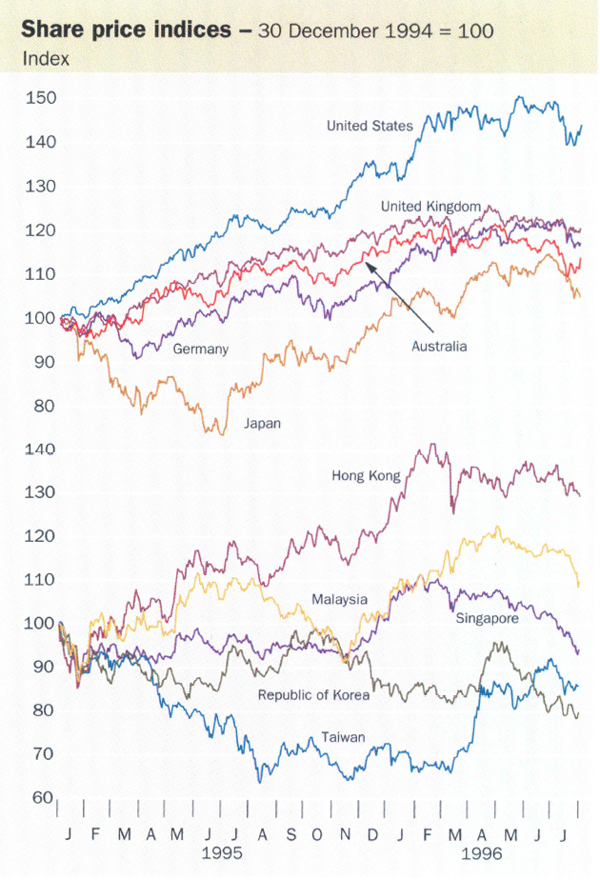
Foreign exchange markets: The Australian dollar rebounded during 1995/96 from its low level during the first half of 1995. International influences played an important role in this turnaround. Of most importance was the perceived linkage between the Australian dollar and commodity prices, with the exchange rate adjusting to any significant shift in Australia's terms of trade. This linkage seems to have become more pronounced in recent years as funds managers have incorporated it in their models, despite some decline in the share of commodities in Australia's total exports. At the same time, the desire on the part of market participants to anticipate developments means that shifts in expectations about the course of world growth, and therefore commodity prices, can lead to changes in the value of the Australian dollar even before any evidence of the underlying forces emerges.
A second factor affecting the Australian dollar over the past year has been the differential between Australian and overseas interest rates. The differential for short-term rates widened as a result of most other countries easing their monetary policies during that period. The very low interest rates in Japan resulted in a strong demand for Australian paper from that country, mainly at the retail level. Inflows associated with these investments helped to underpin the Australian dollar for much of the past year.
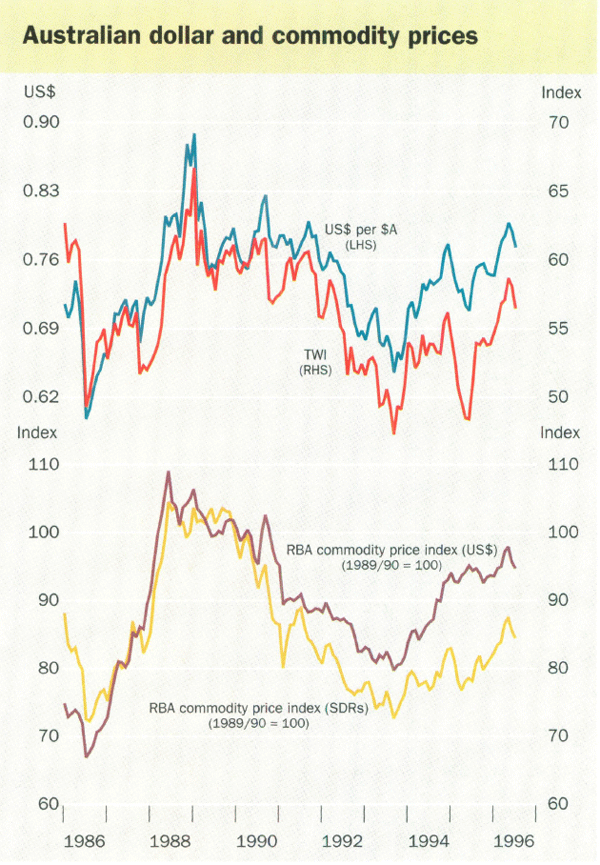
From its low point of US71 cents (48½ in trade-weighted terms) at the start of the financial year, the Australian dollar rebounded as prospects for the US economy and commodity prices improved and, by September, it had risen to around 75 cents against a much stronger US dollar. It weakened a little in the last few months of 1995, on the back of slightly slower US growth, then resumed an upward trend in early 1996 as it became clearer that the slowing in the US had been temporary.

It rose to over US80 cents in May but then softened a little. Initially, this was associated with some easing in commodity prices (particularly metal prices, following revelations of the speculative activities of the Sumitomo Corporation). Heightened expectations of increases in interest rates in the US and Japan also contributed, as did the easing in Australian monetary policy in July, which narrowed the interest differential between Australian and foreign assets. The Australian dollar at end July was 9 per cent higher against the US dollar, and 17 per cent higher in trade-weighted terms, than it was in mid 1995.
The rise in the Australian dollar in trade-weighted index terms over the past year was assisted by the appreciation of the US dollar, which reversed the previous year's decline. In mid 1995, the US dollar had fallen to all-time lows against both the yen and the Deutsche mark. The sharp fall in the US dollar/yen exchange rate had all the hallmarks of a speculative bubble, and was distinctly unhelpful to the Japanese authorities who were faced with the task of restarting economic growth in an environment of deflation of both goods and asset prices. In a similar way, although to a lesser extent, a rise in the mark against the US dollar (and other European currencies) was an unwelcome dampener on economic prospects in Germany, and contributed to the stalling of economic recovery in the second half of 1995.
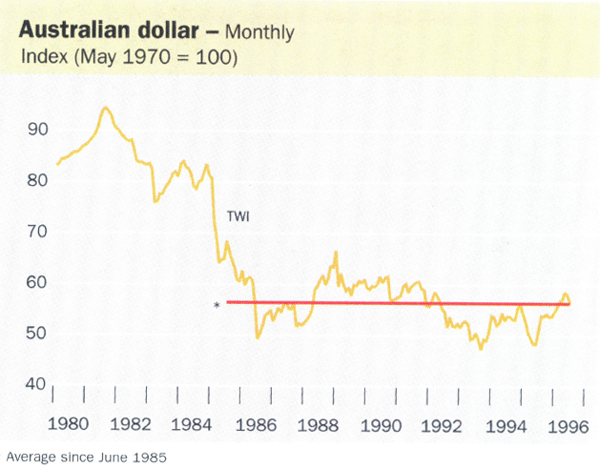
The reversal in the US dollar/yen rate, once it began, proved to be quite rapid. Between early July and mid September 1995, it moved from 85 to 105, an appreciation of the US dollar of over 20 per cent. These developments were assisted by concerted intervention by major central banks. Against the mark, the US dollar's increase was smaller and more protracted, as had been the earlier fall, but it was still significant. While the US dollar weakened a little in mid 1996 in response to the uncertainties surrounding the US share market, it remained 25 per cent higher against the yen and 7 per cent higher against the mark, than a year earlier.
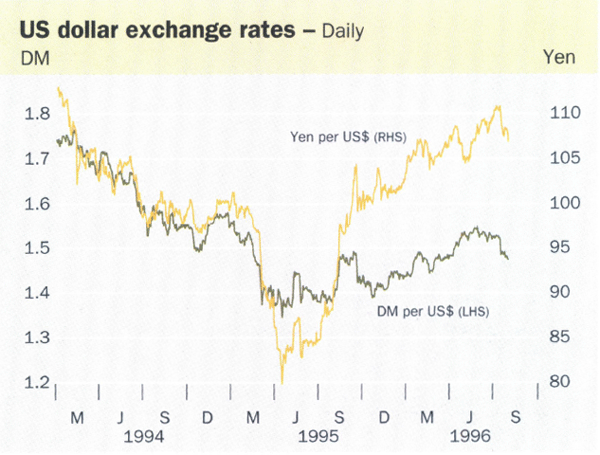
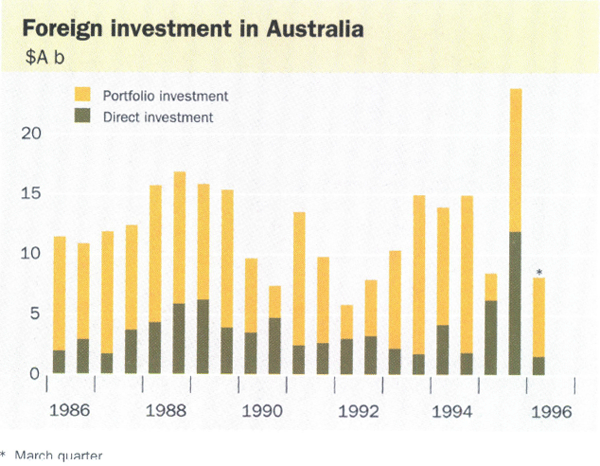
Implications of increased financial market integration: The stronger international linkages among financial markets that have been evident in recent years do not in themselves diminish national authorities' direct control over their domestic monetary policies. They do, however, reinforce the need to take a broad view of economic and financial developments in setting policies, and can sometimes complicate policy making. Difficulties could arise, for example, if these linkages increased the extent to which shocks in a major country were transmitted to other markets, without adequate allowance for local developments. In circumstances – such as in the 1990s – where the underlying business cycles are not synchronised, the consequences could be particularly acute for cyclically weak countries; higher long-term rates flowing on from stronger economies, for example, could thwart their attempts to revive economic growth.
Globalisation of financial markets heightens the interest of countries such as Australia in economic developments and policies in major countries. A world of low inflation will be helpful in maintaining low inflation in this country. Similarly, sustained progress in reducing budget deficits in the United States and other major countries would help to reduce pressures on world capital markets and real interest rates, and therefore on long-term rates in Australia. The potential for shocks, both good and bad, to affect the Australian economy always has been present, and is likely to increase as trade, investment and other linkages grow. These linkages are essential to Australia's long-run prosperity, and are irreversible. They do, however, heighten the need for economic policy makers to enhance their capacity to read, assess and respond effectively to disturbances from abroad.
In the Reserve Bank's domain, this means keeping a close watch on developments in major economies and financial markets. It also emphasises the value of co-operative relationships with other central banks and international monetary institutions, which can be helpful in better understanding and coping with swings in capital flows and other financial shocks. The Bank sees potential benefits in sharing information and experiences, and to this end it has been seeking to enhance its relationships with counterpart institutions, especially in the Asian region.
Effects in financial markets of low inflation
The transition by Australia to a low-inflation economy is beginning to return a number of dividends. One tangible benefit was the scope for easing of monetary policy in late July, which resulted in the overnight interest rate falling to 7.0 per cent, from 7.5 per cent where it had been since the tightening in December 1994, with flow-on reductions in interest rates paid by a wide range of borrowers.
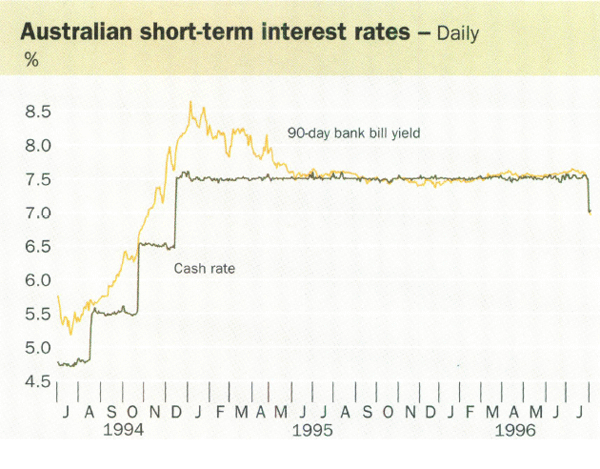
Another benefit, particularly for longer-term borrowers such as governments, has been the marked narrowing in differentials in bond yields between Australia and other countries. That is, the premium over world interest rates which Australia has had to pay in the past because of investor concerns about inflation has been reduced substantially. In the past year, the differential between Australian 10-year bond yields and US yields has narrowed from about 300 basis points to around 150 points; this is well below the differential of about 450 points which applied on average in the second half of the 1980s. The narrowing in interest differentials was particularly noticeable in the middle of 1996 as markets gained confidence that inflation was returning to a level consistent with the Bank's 2–3 per cent objective. It suggests some upgrading of Australia's reputation for economic management in recent years.
Australia's spread relative to the US is still wider than that enjoyed by some other comparable countries, such as Canada, indicating that scope still exists to persuade market participants that Australia can sustain low rates of inflation. Success in this regard would further lower interest costs for both private and public sector borrowers. In the case of the Commonwealth Government, with about $100 billion in debt on issue, a narrowing of 100 points in the differential would, over time, generate budget savings of up to $1 billion a year.
Other benefits of low inflation are flowing through in more subtle, but nonetheless important ways. One example is in the housing market. Lower inflation, with lower interest rates and a normal (ie upward sloping) yield curve, has opened the way for new lenders, such as mortgage managers, to compete strongly with traditional lenders such as banks. The substantial reductions in interest rates on home loans which occurred in mid 1996, before the easing of monetary policy, reflected this more intense competition.
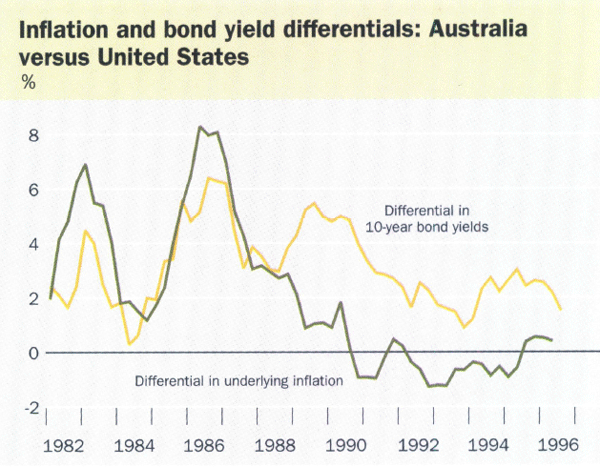
In the share market, the effects of lower inflation have been mixed. The market benefited from the lower interest rates and bond yields flowing from low inflation (low interest rates make shares more attractive) but at the same time businessmen and analysts have been disappointed with the slower rate of growth of profits. Company profits in general last year were below expectations, but most of this shortfall appears to reflect profit projections which were unrealistically high for a low-inflation environment. This made for a fairly subdued performance in the share market in the second half of the year, although the increase in share prices for the year as a whole was a healthy 11 per cent.
The effects on the exchange rate of the better performance on inflation are difficult to disentangle, given the complex ways inflation and interest rates combine to influence exchange rates over different time horizons. It seems clear, however, that the firmness of the Australian dollar against the currencies of countries such as Canada and New Zealand over the past year owed something to the increased confidence in Australia's capacity to run responsible macro-economic policies. Moreover, better control over inflation should contribute to greater exchange market stability. In conditions of high inflation, the trade-exposed sector of the economy can quickly become uncompetitive, leading to an eventual depreciation of the nominal exchange rate; the spectre of such an eventuality can be a significant source of market instability, as well as of a risk premium. Many factors affect exchange rates and misalignments and instability can stem from a variety of sources, but maintenance of domestic price stability will help to neutralise one source.
Reserve Bank operations
Domestic market operations: The Bank's transactions in Commonwealth Government securities (CGS) in recent years are summarised in the table below. Transactions in repurchase agreements and short CGS are undertaken for liquidity and monetary management purposes, and are used to reposition cash from day to day to influence liquidity conditions in the money market and maintain the overnight cash rate at around the Bank's announced target rate. Over the past year there has been some shift away from repurchase agreements to short CGS, reflecting a much more active market in Treasury notes, associated in part with increased amounts on issue (and thereby expanding the scope for the Bank to deal in these instruments).
Transactions in longer-term bonds are undertaken mainly as part of the Bank's own portfolio management. During the past year, the Bank was a small net seller of bonds; these sales were undertaken in the first half of the financial year when yields had fallen to low levels, reversing purchases made in the previous year when yields were significantly higher.
Domestic market operations
($ billion)
| 1994/95 | 1995/96 | ||
|---|---|---|---|
| Repurchase agreements | purchases | 100.5 | 84.3 |
| sales | 97.8 | 85.1 | |
| Short CGS | purchases | 8.5 | 23.8 |
| sales | 1.2 | 1.7 | |
| Longer-term bonds | purchases | 2.3 | 2.1 |
| sales | 0.7 | 3.5 | |
The Bank also conducts tenders of securities on behalf of the Commonwealth Government. Details of each tender are determined by the Treasury having regard to the Commonwealth's financing needs. During the year, 10 tenders for Treasury bonds were held, raising a total of $7.6 billion from the public; the Bank took up only a small amount ($0.2 billion) at one of these tenders for its own portfolio needs. There were six issues of Treasury indexed bonds totalling $0.6 billion; tenders for Treasury notes were held each week. In April 1996, the Treasury announced that future issues of Treasury adjustable rate bonds (TABs) would be by competitive tender, rather than through an underwritten syndicate arrangement. Two tenders were held under the new arrangements during the year, and one issue was made under the previous syndicate arrangement; in total, $3.4 billion of TABs were issued during 1995/96, of which a small amount was taken up by the Bank for its portfolio.
The arrangements under which the Bank conducts its domestic market operations have been changed in the lead-up to the introduction of real-time gross settlement (RTGS) in late 1997. The changes, which were intended to avoid disruption to markets during the transition to RTGS and had no implications for the operation of monetary policy, comprised three components:
- On 12 June 1996, the Bank broadened the range of counterparties it is prepared to deal with from authorised short-term money market dealers to all members of the Reserve Bank Information and Transfer System (RITS).
- On 12 July 1996, the Bank began to pay interest on balances remaining overnight in Exchange Settlement Accounts of banks and Special Service Providers. With the winding-down of the authorised dealers, these accounts have become the repository of liquid funds of the banks. The interest rate has been set initially at 10 basis points below the Bank's announced target for the overnight cash rate, the margin being designed to preserve the status quo in terms of banks' return on their exchange settlement funds.
- On 9 August 1996, the Bank withdrew all facilities that it provided to the authorised short-term money market dealers. This effectively marked the end of the “official” short-term money market, which had been created by the Bank in 1959. The authorised dealing companies have either been wound up or absorbed into their parent organisations.
Foreign exchange operations: The Bank made substantial purchases of foreign exchange during 1995/96. One element of this involved covering the foreign exchange needs of the Commonwealth Government. The Government's net requirement for foreign currency from the Bank was equivalent to about $A4.9 billion and, in keeping with its usual practice, the Bank covered these sales by market purchases at opportune times. The Bank had not needed to enter the market on the Government's account in the previous couple of years, when the Government drew upon funds available from its swaps program and had little net requirement for foreign exchange.
In addition to covering Government business, the Bank undertook some purchases of foreign exchange on its own account over the past year. These purchases were intended not to influence the exchange rate, but to facilitate a further run-off of outstanding swaps accumulated during 1992 and 1993 when the Bank had intervened heavily to support the Australian dollar. By June 1996, the oversold swap position had been reduced to $A5.4 billion, compared with $A8.8 billion in June 1995 and a peak of $11.1 billion in late 1993.